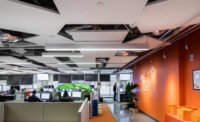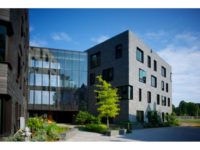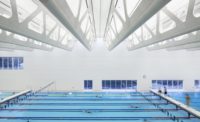Akamai Technologies, the intelligent edge platform for securing and delivering digital experiences, recently opened its new global headquarters for its 1,800 employees. Located at 145 Broadway Street in Cambridge, Massachusetts, the 19-story facility is the tallest office building in Kendall Square.
Focused on enhancing the staff's experience in an attractive, healthy and productive workplace, the building also is designed to achieve both the U.S. Green Building Council's LEED Gold certification and the International WELL Building Institute's certification. Optimized acoustics, indoor air quality, natural and recycled materials, energy efficiency and daylight all contribute to achieving sustainability and well-being goals.
Opened in November 2019, the new, high-performance facility replaced an aging, four-story, 80,000-square-foot brick building. Boston Properties developed and owns the new building, where Akamai holds a 15-year lease. Where Akamai previously leased six area buildings, the new headquarters unites local employees together under a single roof.
The project team's additional members included: Stantec (formerly ADD Inc.) as the architect-of-record, Pickard Chilton as the exterior architect, Turner Construction as the construction manager, Northstar Project & Real Estate Services as the project manager, Acentech Incorporated as the acoustician and Sasaki as the interior architect. Working closely with Acentech, Sasaki specified Rockfon's acoustic ceiling systems, which were provided by Merrimack Building Supply and installed by Allan Construction.
Unified, Connected
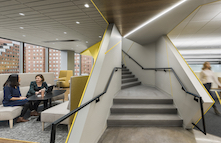
Akamai's vision for its new headquarters was a singular, unified campus, connecting all the departments and groups harmoniously. The new facility organizes all collaborative spaces around a curved, continuous path that stretches from the lobby to the top floor, encouraging both planned encounters and serendipitous interactions. A mile-long path, dubbed the "AkaMile," begins in the lobby at street level, greeting customers and employees with interactive displays and warm, welcoming textures and tones.
Anthony Williams, vice president of global talent acquisition and diversity at Akamai, told the Boston Globe: "We want everyone to connect. As we've become a larger company, it has become harder to do that. We have to really work to create opportunities for collaboration."
Sasaki saw productive collaboration across the building's 19 floors as a challenge, but also as an opportunity for innovative design. A visitor's initial impression on entering the lobby is one of warmth, welcome and energy. Diverse destinations – including a specialty coffee bar, a ping-pong arena, and an inviting gaming lair, among others – encourage movement across the entire building, and the AkaMile guides employees through common spaces on each floor.
Open Office, Optimized Acoustics
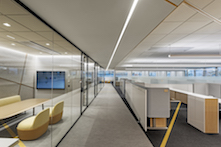
Sasaki's engagement process with Akamai's team ensured the resulting workspaces matched their needs. Engineers, who represent 50% of the employees in this building, required areas that allowed for deep focus and concentration. Others expressed the need for huddle rooms where they could work together in small groups.
Supporting concentration and privacy, Rockfon's Optimized Acoustics approach involves a combination of sound-absorbing ceiling systems and sound-blocking, full-height walls. With more than 90% of an organization's operating costs linked to employee efficiency, optimal office acoustics can have a positive effect on the bottom line.
"Acoustics were important on this project," said Rockfon's district sales manager, Tom Luby. "The walls go to the deck to block sound between adjacent rooms and Rockfon's stone wool ceiling panels offer a high NRC to absorb sound within them."
Luby emphasized the importance of selecting the right ceiling panel and corresponding NRC necessary to meet the function and sound absorption needs of the individual, group and open spaces, and to comply with the standards. For example, in Akamai's breakrooms and recreational area, Rockfon Koral has an NRC of 0.85 for better sound absorption, without damping the energetic camaraderie of these spaces. Rockfon Color-all panels have an NRC of 0.95 for even higher sound absorption in the presentation area, boardroom, huddle rooms and private offices.
Sustainable Well-being in the Workplace
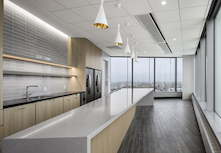
This highly efficient building also serves as a physical demonstration of Akamai's commitment to mitigate the environmental impact of its global operations. The project incorporated sustainable choices at every step.
LEED v4 and WELL include improved indoor environmental quality as part of their guidelines for green and healthy buildings. Both programs recognize GREENGUARD Gold certified products, such as Rockfon's stone wool ceiling panels, as contributing to these goals. Stone wool and metal provide no sustenance to mold, mildew and other potentially harmful microorganisms, and also resist water, moisture and humidity.
Research shows that better indoor air quality and increased daylighting can further improve workplace productivity. In Akamai's offices, more than 70% of the building's workstations are within 20 feet of a window. Maximizing daylight also helps reduce the demand for electric lights and the associated HVAC, energy consumption and related emissions.
Private offices with window access allow natural light to pass through the glass partitions. The high reflectance of Rockfon's white ceiling panels extend light into the central, open offices and reinforce the transparent, collaborative work culture of the organization. Above the open workstations and in the corridors, 86% the percent of light is reflected off the ceiling panels.
Purpose-Driven Aesthetic
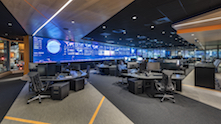
Complementing the white ceilings, a neutral palette with bright pops of color compose Akamai's interior. The floors are color-categorized along a gradient of Akamai's brand colors, which also acts as intuitive wayfinding for employees as they travel from one story to the next.
The lobby level warmly greets visitors in Akamai's signature orange. By the sixth floor, the hue has transitioned to yellow, and onto green by the twelfth. The top story culminates in Akamai's vibrant blue. Traversing all floors is a pattern of intersecting lines, signaling "hot spots" of activity as the lines become more concentrated.
Colors also denote public and private work areas. The bold, primary colors indicate shared spaces such as the boardroom, café, libraries and connecting points along the AkaMile. Individual workspaces present a more quiet and neutral color palette.
Matching the visual coding of Akamai's interiors, Rockfon provided ceiling panels a variety of colors. In addition to the white ceilings installed in the breakrooms, open offices and corridors, a Hemp color panel was used for the huddle rooms and private offices. Color-all Black ceiling panels were placed in the presentation room to enhance the audio-visual experience.
Keeping with the work-centric neutral palette, Color-all Stone ceiling panels were designated to the boardroom and another meeting room was appointed in custom Galveston Gray. Galveston Gray ceiling panels and a lively Curacao blue also were installed in the employee recreation area.
Depending on the floor and room, some of the ceiling suspension systems also were finished to match the panels' colors. Throughout the building, Allan Construction installed all of Rockfon's stone wool ceiling panels using Chicago Metallic 4000 Tempra and 1200 15/16-inch suspension systems. In total, more than 292,500 square feet of metal ceiling grid was installed.
Rockfon's metal ceiling systems are manufactured with recycled content, and at the end of their useful life on a building, are 100% recyclable. Specifying recycled and recyclable materials further supports the building's green goals. LEED Gold and WELL certification is in progress and anticipated in 2020.
Sasaki concluded, "The new headquarters positions Akamai in the public eye as an integral player in the realm of internet technology. Full of surprising and beautiful design moments, attention to detail, and artful use of color, the office is unlike any other in the region. But even more importantly, along with thoughtful aesthetics, the design is optimized for Akamai's business – creating a joyful place for clients and employees to return to, streamlining internal workflow, prompting moments of collaboration – all to enable Akamai to do their best work in connecting the rest of us with the world."

